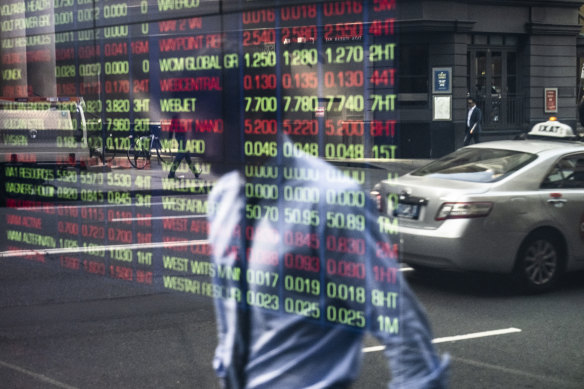ASX starts week on a high with inflation the key focus
By Staff reporters
The Australian sharemarket has started the week on a high, with local investors betting that interest rates are likely to stay put in the near-term.
The ASX 200 index closed the session 0.9 per cent, or 68.3 points, stronger at 7989.6 points, as the market braces for a week punctuated by central bank meetings overseas and the release of key domestic inflation data.
The major banks, except for ANZ, closed in the green, with Westpac leading the pack with gains of 1.4 per cent. NAB and CBA both closed 1.3 per cent higher, while ANZ dropped 1.2 per cent.
Iron ore miners lost their shine after a bright start to the day, with Fortescue giving up its gains from the morning to close flat. Rio Tinto ended 0.03 per cent lower, while BHP closed 0.07 per cent weaker.

The ASX 200 has made a good start to the week, with investors focused on upcoming inflation data. Credit: Louise Kennerley
Buy now, pay later outfit Zip (up 4 per cent) and building products group James Hardie (up 2.8 per cent) enjoyed healthy sessions.
Ailing casino operator Star Entertainment had a stellar session, jumping 14.7 per cent and Adore Beauty (up 3.2 per cent) recovered from a slow start to finish in the green after it announced the appointment of former General Pants Co and Collette chief executive Sacha Laing to be its new boss from October.
Meanwhile, NZ-based Fletcher Building slid 6 per cent after telling the market that its fiscal 2025 earnings would take a hit because of supply chain issues affecting its cement business. Health insurer NIB (down 0.5 per cent) slipped on the news that its CEO Mark Fitzgibbon will retire in September.
Online retailer Kogan closed in the red, down 0.9 per cent, after it delivered a mixed update to the market and Rex Airlines’ shares have been placed in a trading halt.
Australian investors will keep a close eye on the quarterly inflation data out this week, which will provide clues as to where the Reserve Bank of Australia is going next with rates.
Headline consumer prices probably advanced 3.8 per cent in the second quarter from a year earlier, from 3.6 per cent in the prior period, economists predicted ahead of Wednesday’s release of the inflation data. Trimmed mean inflation, which smooths out volatile prices and is a key core measure, is seen holding at 4 per cent. That is above the Reserve Bank’s latest forecast of 3.8 per cent and suggests limited progress in reining in prices.
“If inflation is four-point something and they don’t raise, it starts to substantially bite into their inflation-fighting credibility,” said Stephen Miller, an investment strategist at GSFM. “What that might mean is the longer tenor bond yields in Australia struggle and certainly underperform the US.”
The Reserve Bank has raised rates by less than global counterparts as it sought to hold on to employment gains while being worried about the capacity of heavily indebted households to cope. Stubborn inflation that suggests the RBA would fail to meet its goal of returning price gains to the 2 to 3 per cent target late next year is likely to require a further hike — and risks tipping a weak economy into recession.
The price report comes on the heels of higher-than-forecast jobs growth and strong retail sales, while measures of business surveys remain resilient. A partial gauge of prices rose by more than expected for a third straight month in May, raising questions over whether policy is “sufficiently restrictive.”
The RBA has pledged to be “vigilant” on upside price risks and the rate-setting board considered a hike in June, before deciding to stand pat at 4.35 per cent. Although the odds are lower from earlier this month, money markets are still pricing a one-in-five chance that the Reserve Bank will raise the rate at the August 5-6 meeting.
“Inflation in Australia is still high relative to its global peers,” said Diana Mousina, deputy chief economist at AMP. She reckons a quarterly result above 1 per cent “would probably lead to the Reserve Bank hiking” as it would be farther away from its inflation goal.

Every major group in the US S&P 500 index rose on bets that a Fed easing cycle will keep fuelling Corporate America.Credit: Bloomberg
On Friday, every major group in the US S&P 500 rose on bets that a Fed easing cycle will keep fuelling corporate America — with the bull market broadening beyond a narrow group of companies. While big tech has enjoyed massive gains this year, the so-called concentration risk has come to the forefront after a disappointing start of the megacap earnings season.
The S&P 500 rose 1.1 per cent, the Dow Jones Industrial Average climbed 1.6 per cent, while the Nasdaq 100 added 1 per cent.
The Fed’s preferred measure of underlying US inflation — the core personal consumption expenditures price index — rose at a tame pace in June and spending remained healthy. US consumer sentiment eased in July to an eight-month low.
The rotation into economically sensitive shares has been fuelled by Fed-friendly data. Investors who for months saw fewer alternatives to a tight group of market winners were suddenly faced with more choices. Financial, industrial and staples shares have largely beaten tech in July. Small caps have rallied 10 per cent on bets they’d do better amid lower rates given their higher debt loads.
“We’ve seen this strength in small caps — a significant rotation not seen in decades,” said George Maris at Principal Asset Management. “As we see earnings likely broaden out and recover, you’re going to see greater enthusiasm for those smaller cap names. There is going to be lasting power to this rotation.”
With Bloomberg
The Business Briefing newsletter delivers major stories, exclusive coverage and expert opinion. Sign up to get it every weekday morning.